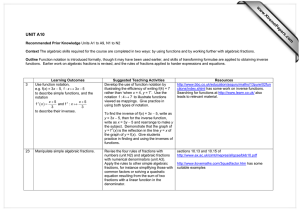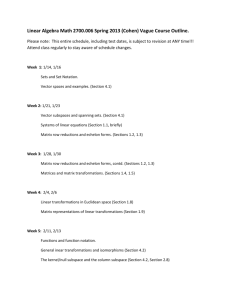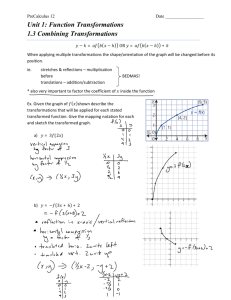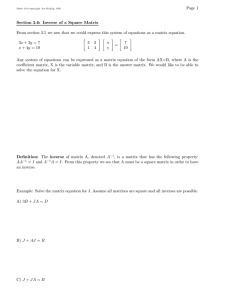UNIT A10
advertisement
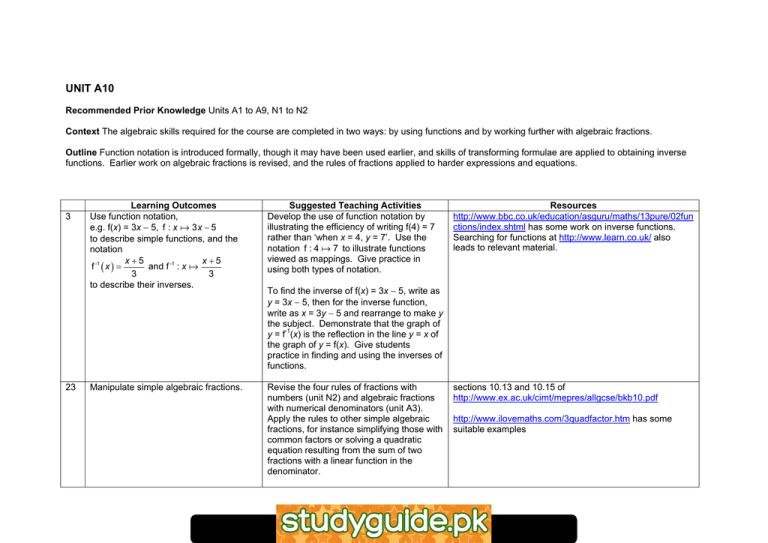
UNIT A10 Recommended Prior Knowledge Units A1 to A9, N1 to N2 Context The algebraic skills required for the course are completed in two ways: by using functions and by working further with algebraic fractions. Outline Function notation is introduced formally, though it may have been used earlier, and skills of transforming formulae are applied to obtaining inverse functions. Earlier work on algebraic fractions is revised, and the rules of fractions applied to harder expressions and equations. 3 23 Learning Outcomes Use function notation, e.g. f(x) = 3x − 5, f : x a 3 x − 5 to describe simple functions, and the notation x+5 x +5 f -1 ( x ) = and f -1 : x a 3 3 to describe their inverses. Suggested Teaching Activities Develop the use of function notation by illustrating the efficiency of writing f(4) = 7 rather than ‘when x = 4, y = 7’. Use the notation f : 4 a 7 to illustrate functions viewed as mappings. Give practice in using both types of notation. Manipulate simple algebraic fractions. Revise the four rules of fractions with numbers (unit N2) and algebraic fractions with numerical denominators (unit A3). Apply the rules to other simple algebraic fractions, for instance simplifying those with common factors or solving a quadratic equation resulting from the sum of two fractions with a linear function in the denominator. Resources http://www.bbc.co.uk/education/asguru/maths/13pure/02fun ctions/index.shtml has some work on inverse functions. Searching for functions at http://www.learn.co.uk/ also leads to relevant material. To find the inverse of f(x) = 3x − 5, write as y = 3x − 5, then for the inverse function, write as x = 3y − 5 and rearrange to make y the subject. Demonstrate that the graph of y = f-1(x) is the reflection in the line y = x of the graph of y = f(x). Give students practice in finding and using the inverses of functions. sections 10.13 and 10.15 of http://www.ex.ac.uk/cimt/mepres/allgcse/bkb10.pdf http://www.ilovemaths.com/3quadfactor.htm has some suitable examples www.xtremepapers.net UNIT S10 Recommended Prior Knowledge Units S5, A9 Context Work on transformations studied in S5 is taken further, particularly in using the work on matrices studied in A9. Outline Relevant matrix products are evaluated and their application to transformation geometry are demonstrated. Further work leads to obtaining the matrices for basic transformations and for combinations of transformations. The transformation from an object to its image is identified and described. 38 Learning Outcomes Use the following transformations of the plane: reflection (M), rotation (R), translation (T), enlargement (E), shear (H), stretching (S) and their combinations. (If M(a) = b and R(b) = c the notation RM(a) = (c) will be used; invariants under these transformations may be assumed.) Identify and give precise descriptions of transformations connecting given figures; describe transformations using coordinates and matrices. (Singular matrices are excluded.) Suggested Teaching Activities Ask students to do a matrix multiplication ⎛ 1 0 ⎞ ⎛1 1 4 ⎞ such as ⎜ ⎟⎜ ⎟ then show them ⎝ 0 −1⎠ ⎝ 1 3 1 ⎠ how this can be interpreted as transforming the triangle with coordinates (1, 1) (1, 3) and (4, 1) by reflecting it in the x axis. Invite the students to explore with other triangles etc and other 2 × 2 matrices, giving them matrices which refer to the required transformations, until the students can classify the basic matrices which represent certain transformations. Resources websites such as http://www.hannasd.k12.pa.us/sths/departments/mathdept/ Yohe2/trans.htm and http://nrich.maths.org/askedNRICH/edited/876.html and the first page of http://staff.imsa.edu/math/journal/volume4/articles/GeomMa trices.pdf have material on using matrices with transformations Show students how the matrix for a given transformation may be obtained by considering its effect on the square with vertices at (0, 0) (1, 0) (1, 1) and (0, 1) with the images of (1, 0) and (0, 1) forming the columns of the matrix. Show students how the inverse of a matrix representing a transformation represents the inverse of the transformation. Use and describe combinations of transformations, using both coordinates www.xtremepapers.net and matrices. www.xtremepapers.net
